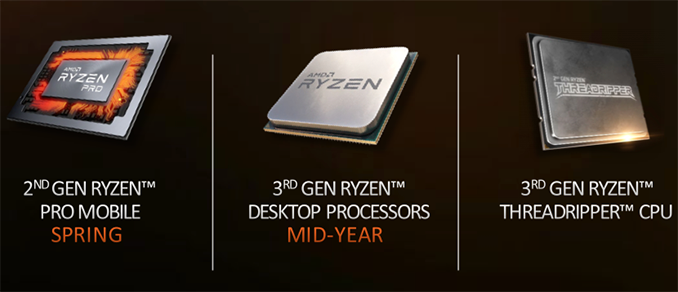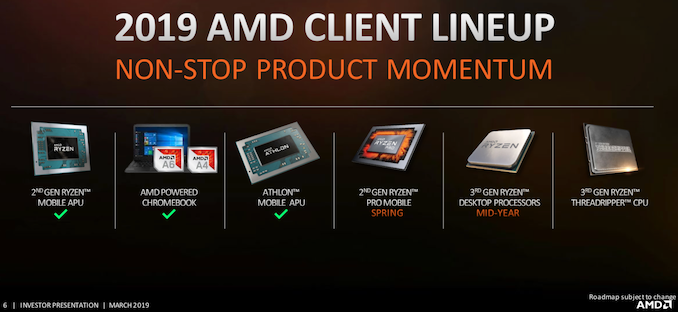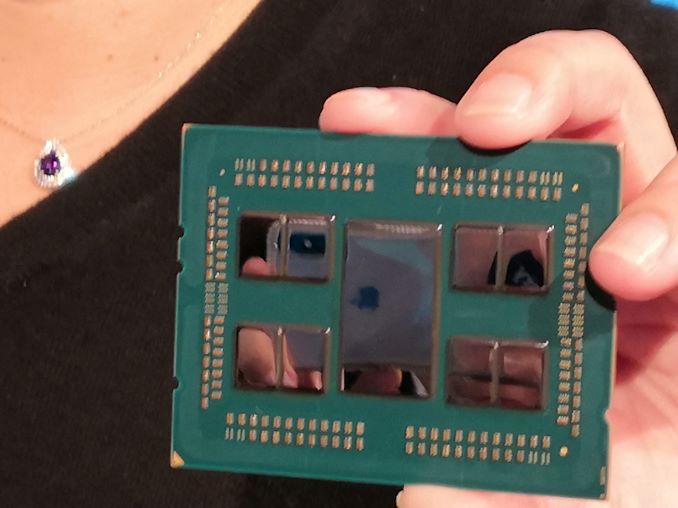AMD: 3rd Gen Ryzen Threadripper in 2019
by Anton Shilov on March 6, 2019 12:20 PM EST- Posted in
- CPUs
- AMD
- APUs
- Ryzen
- ThreadRipper
- Rome
- Ryzen 3rd Gen
- Matisse

In a new presentation for investors AMD announced a more precise launch plan for its client APUs and CPUs for desktop, mobile, and server computers. The company is preparing to update its whole lineup of products for different types of client and server machines later this year.
As it turns out, AMD intends to release its 2nd Generation Ryzen Pro mobile products for notebooks this spring. AMD also plans to introduce its 3rd Generation Ryzen processors sometimes in the middle of the year. A bit later on the company is set to launch its 3rd Generation Ryzen Threadripper CPUs for extreme desktops and workstations. AMD’s codenamed Rome processors for servers are also due in 2019, but the manufacturer does not elaborate about their exact timing.
AMD’s 2nd Gen Ryzen Pro 3000-series quad-core processors are based on the Zen+ microarchitecture and are made using GlobalFoundries’ 12LP process technology, just like their non-Pro counterparts. The latter are set to become available in the near future, so we are going to learn more about what to expect from these upcoming APUs shortly.
AMD’s 3rd Gen Ryzen processors for desktops rely on the brand-new design code-named Matisse. Matisse features two dies: a chiplet die containing eight cores based on the Zen 2 microarchitecture, and built using TSMC’s 7N manufacturing process; and an I/O die featuring PCIe 4.0 lanes, and built using GlobalFoundries’ 14LPP fabrication technology.
AMD’s 2nd Gen EPYC (codenamed Rome) and 3rd Gen Ryzen Threadripper processors have a lot in common. EPYC will have eight 7nm Zen 2-based chiplets to provide up to 64 cores and an IO die. We expect the 3rd Gen Ryzen Threadripper to be built on the same platform, but we don't expect to see parity on power/core/frequency based on how the first generation Threadripper only offered half the cores of the 1st Gen EPYC. We would be pleasantly surprised if there was core configuration parity!
This is a breaking news. We are adding more details as we learn them.
Related Reading:
- AMD Previews EPYC ‘Rome’ Processor: Up to 64 Zen 2 Cores
- AMD Ryzen 3rd Gen 'Matisse' Coming Mid 2019: Eight Core Zen 2 with PCIe 4.0 on Desktop
- The AMD Keynote at CES 2019: Looking Ahead
- AMD Reveals Radeon VII: High-End 7nm Vega Video Card Arrives February 7th for $699
Source: AMD













58 Comments
View All Comments
Santoval - Saturday, March 9, 2019 - link
16-core Ryzen CPUs, assuming they are released, will be highly memory bandwidth constrained due to the platform's 2 memory channels. However 16 cores with 2 memory channels is equivalent to 32 cores with 4 memory channels and 64 cores with 8 memory channels : these CPUs all have 1 memory channel per 8 cores.So if 8 cores are indeed memory limited with 2 channels (i.e with 1 channel per 4 cores) the problem with upcoming high core count Zen 2 based CPUs will become twice as worse. It probably doesn't make sense to get a Threadripper with less than 16 cores, but even with 16 cores and 4 memory channels it is just equivalent to a 8-core Ryzen with 2 channels memory bandwidth wise (though with many more PCIe lanes).
Will the I/O die have an extra L4 cache to alleviate the memory bandwidth pressures or would that only make them worse (if the L4 cache's latency was not low enough)? Maybe an L4 cache will be added only to Epyc's large I/O die and possibly to Threadripper's? I have no idea.
shing3232 - Wednesday, March 6, 2019 - link
NOPE,there would be 32Core or maybe even 64Core.PixyMisa - Wednesday, March 6, 2019 - link
And the new I/O die means they can have anything from 4 to 64 cores and still have full memory and PCIe support.tamalero - Wednesday, March 6, 2019 - link
They could enforce segmentation by only allowing low frequencies on the AM4 high core offerings.Example.. 16 core, max PBO and XFR2 4Ghz
Max Threadripper 32 core PBO and XFR = 5 Ghz
sbrown23 - Wednesday, March 6, 2019 - link
It doesn't appear they're going to be doing that. Current rumors have Ryzen 3rd Gen parts with 12 and 16 cores in the 4-5GHz range. If they want to gain marketshare back from Intel, I don't think they will want to artificially clock limit the more mainstream parts. I'm guessing Intel will still have a bit of an IPC advantage, so AMD will probably want to beat them with cores and clocks.Kevin G - Wednesday, March 6, 2019 - link
Clock speeds should all universally move with AMD's design approach. They can bin the chiplets before putting them into packing so that chips that bin the same are packaged the same. This creates uniformity.The clock uptick stems of yield probabilities and they are using a smaller CPU die. There is simply less chance that a single low clocked core can bring down the entire SoC's performance slot. If even there is a core that simply won't clock as high as the rest, AMD can fuse that off to bring forward 12 designs at high clocks. AMD's strategy here is very flexible in what they can bring to market.
MonkeyPaw - Wednesday, March 6, 2019 - link
Nah, HDET has always been for specific customers, and there will always be buyers that want these extreme configurations. MOST users will be better off buying a desktop-class rig, but that has always been the case. How many people even get the most use of 6-8 cores? In my mind, Ryzen 2 needs more single thread performance—more IPC, more clockspeed.Thunder 57 - Thursday, March 7, 2019 - link
One word: Handbrake. Also Battlefield runs better on my 6 core than it did my old quad core.SunLord - Wednesday, March 6, 2019 - link
I'd figure the main benefit of threadripper is for people who want lots of RAM and lots of pcie cards or nvme drivesfazalmajid - Wednesday, March 6, 2019 - link
I'd love a Threadripper as a single-box compile farm. It's unfortunate how massively huge the TR boxes are, I much prefer SFF cases as I don't need GPUs and storage is in M.2 NVMe drives, so lots of drive bays is not a requirement either.